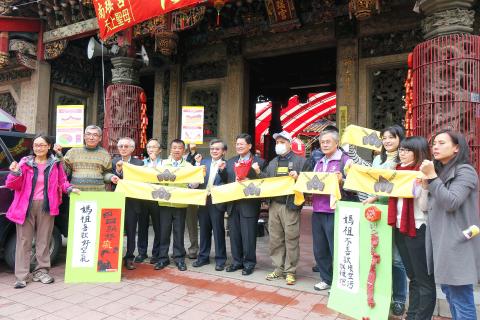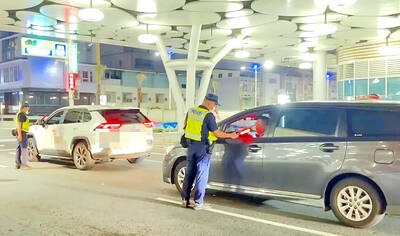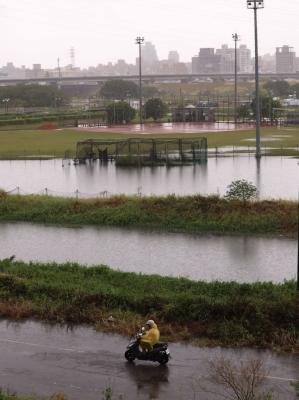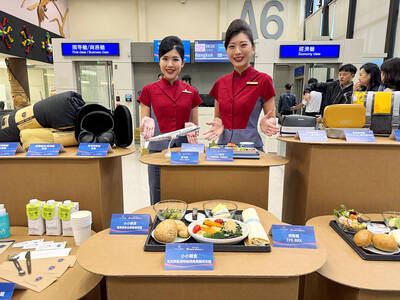Environmentalists yesterday urged Matsu devotees to refrain from setting off firecrackers, or burning incense and joss paper ahead of an annual religious festival next month to reduce air pollution.
Campaigners gathered at Nanyao Temple (南瑤宮) in Changhua City — the first stop of the annual Dajia Matsu Pilgrimage, one of the most celebrated religious activities in Taiwan — and presented a bouquet of flowers to Changhua Mayor Chiu Chien-fu (邱建富), urging people to replace incense and firecrackers with flowers.
Environmentalists measured air pollution levels inside and outside the temple with handheld devices, and recorded concentrations of PM2.5 — particulate matter measuring 2.5 micrometers or less in diameter — of between 50 micrograms per cubic meter and 60 micrograms per cubic meter outside of the temple.

Photo: Liu Shiao-hsin, Taipei Times
However, concentrations of PM2.5 reached more than 200 micrograms per cubic meter near incense burners inside the temple, illustrating the severity of air pollution caused by incense burning.
According to Environmental Protection Administration criteria, PM2.5 levels higher than 54 micrograms per cubic meter are considered hazardous.
Changhua Medical Alliance deputy director Chen Chih-yuan (陳志遠) said during an anti-pollution campaign in Nantou’s Puli Township (埔里) last year that PM2.5 levels were about 15 micrograms per cubic meter, but the level soared to 319 micrograms per cubic meter after a local temple set off fireworks in celebration of the birthday of a god.
“Air pollution caused by religious activities can be more serious than haze in China,” Chen said.
Taiwan Healthy Air Action Alliance founder Yeh Guang-peng (葉光芃) said burning incense generates benzene and polycyclic aromatic hydrocarbons, which can cause respiratory diseases, while particulate matter resulting from incense burning are smaller than bacteria and can easily enter the human body.
Fight for Health Women’s Group executive director Yen Shu-nu (顏淑女) said environmental protection is not in conflict with religions, and replacing ghost money with food offerings or charitable deeds has become a common trend.
“There are 91 temples in the city, but only 15 practice environmentally friendly worshiping. We called on the city office to encourage more temples to follow suit and reduce air pollution,” Yen said.
She said the group asked the city office to monitor air quality during the whole pilgrimage and to make public data collected to serve as a basis for future pollution reduction efforts.
Chiu said the office has instructed temples to reduce the number of incense burners, use fewer and thinner incense sticks and build environmentally friendly furnaces to burn ghost money.
The Changhua County Government has provided temples with electronic firecrackers to reduce the use of traditional fireworks during religious activities, Chiu added.

TRAFFIC SAFETY RULES: A positive result in a drug test would result in a two-year license suspension for the driver and vehicle, and a fine of up to NT$180,000 The Ministry of Transportation and Communications is to authorize police to conduct roadside saliva tests by the end of the year to deter people from driving while under the influence of narcotics, it said yesterday. The ministry last month unveiled a draft of amended regulations governing traffic safety rules and penalties, which included provisions empowering police to conduct mandatory saliva tests on drivers. While currently rules authorize police to use oral fluid testing kits for signs of drug use, they do not establish penalties for noncompliance or operating procedures for officers to follow, the ministry said. The proposed changes to the regulations require

The Executive Yuan yesterday announced that registration for a one-time universal NT$10,000 cash handout to help people in Taiwan survive US tariffs and inflation would start on Nov. 5, with payouts available as early as Nov. 12. Who is eligible for the handout? Registered Taiwanese nationals are eligible, including those born in Taiwan before April 30 next year with a birth certificate. Non-registered nationals with residence permits, foreign permanent residents and foreign spouses of Taiwanese citizens with residence permits also qualify for the handouts. For people who meet the eligibility requirements, but passed away between yesterday and April 30 next year, surviving family members

Taipei, New Taipei City, Keelung and Taoyuan would issue a decision at 8pm on whether to cancel work and school tomorrow due to forecasted heavy rain, Keelung Mayor Hsieh Kuo-liang (謝國樑) said today. Hsieh told reporters that absent some pressing reason, the four northern cities would announce the decision jointly at 8pm. Keelung is expected to receive between 300mm and 490mm of rain in the period from 2pm today through 2pm tomorrow, Central Weather Administration data showed. Keelung City Government regulations stipulate that school and work can be canceled if rain totals in mountainous or low-elevation areas are forecast to exceed 350mm in

China Airlines Ltd (CAL) yesterday morning joined SkyTeam’s Aviation Challenge for the fourth time, operating a demonstration flight for “net zero carbon emissions” from Taiwan Taoyuan International Airport to Bangkok. The flight used sustainable aviation fuel (SAF) at a ratio of up to 40 percent, the highest proportion CAL has achieved to date, the nation’s largest carrier said. Since April, SAF has become available to Taiwanese international carriers at Taipei International Airport (Songshan airport), Kaohsiung International Airport and Taoyuan airport. In previous challenges, CAL operated “net zero carbon emission flights” to Singapore and Japan. At a ceremony at Taoyuan airport, China Airlines chief sustainability